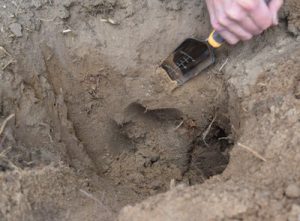Not much beats the taste and nutrition of fresh vegetables that travel from your garden to your kitchen! Or the fragrance of fresh cut flowers that go straight to your vase. What are some ways you can use – or re-use in many cases – natural materials from your yard to enhance your gardens?
Of course, various plants require various soil types. For your vegetable garden, healthy soil is a mix of minerals, open space (called pores), and organic matter. Although only about five percent at most of a healthy soil is organic matter, it is a key ingredient that you must nurture. Organic matter includes everything from living things like soil bacteria and earthworms, all the way down to dead leaves that were once living plants and are now decomposing. This is important because this decomposing plant “litter” is what microorganisms and earthworms in the soil feed on. So essentially when we add dead organic matter to the soil, we are helping it be alive!
How do we build soil fertility naturally in order to feed our garden? The simple answer is to build soil organic matter.
Not all organic matter is created equal. Sawdust is a type of organic matter, but adding large quantities to your soil won’t result in increased fertility of the soil. Why? It isn’t balanced in nutrients. The soil needs a balanced diet just like we do! So what are some balanced meals for our soils?
Compost! Well aged compost is a good source of organic matter and will bring in a wide variety of nutrients. The amount of these nutrients will vary based on what the compost was made out of.
Manure is another good option, but it is important to realize manure can sometimes be too high in nitrogen. If so, it can burn young tender plants. Improperly or un-aged manure can also sometimes carry pathogens like E.coli. Manure that has been well composted and reaches hot enough temperatures to kill potential pathogens is a safe alternative. To learn more about safe manure practices, visit here.
What about back yard cover crops? Cover crops are grasses or legumes (clover, peas, or beans) that are planted not to be harvested, but for the impacts they have on soil health or soil nutrition. Grasses tend to add a lot of organic matter, and legumes add a lot of nitrogen when they are mowed and tilled into the soil. Cover crops are definitely an option in the backyard garden, and legumes are an easy way to essentially grow your own nitrogen fertilizer.
Some good choices of winter cover crops might be red clover which only grows to about 12-16’’ tall and can add around 2 pounds of nitrogen per 1,000 square feet. Be sure to mow it before it sets seed! Mustard cover crops can help suppress soil disease. Both types are easy enough to mow in spring to prepare your garden for planting. Depending on your goals, you can directly plant your crop through the mowed down cover crop, or till the cover crop residue into the soil and then in a few weeks set out your garden plants.
One key to using natural sources of nutrients is that they are often very slow release, though some poultry litters can have more readily available nitrogen and phosphorus. Further it can take several years to build up your organic matter in the soil to the point that it contributes to soil fertility.
Other sources of natural fertilizers include blood meal. It is a good source of nitrogen. For phosphorus, you can try bone meal. Both can be sprinkled around plants and watered in or incorporated into the soil before you plant. Kelp meal is a good source of potassium and is derived from dried kelp and seaweed.
One easy way to monitor nutrient levels is by testing your soil on a yearly basis. You may have to request that your lab provide you the results for the amount of soil organic matter, so be sure to check. Natural levels of soil organic matter can vary substantially from region to region. In the South levels of 1% are not uncommon, in parts of the Midwest 5% may be more common. The important thing will be to track soil organic matter over time. Don’t expect to see big increases or any increase at all even after several years. A 1% increase in soil organic matter is huge and may not be possible on all soils in all climates. Soil testing is more useful for monitoring how the organic matter you are adding to the soil is impacting soil nutrient content so you know what nutrients are in short supply and may need to be added from another source. Soil testing is also important to monitor soil pH, a measurement of how acidic or alkaline the soil is, which has a big effect on the availability of nutrients within the soil.
So before you get planting next season, remember no matter what veggies you choose to grow, well fed soils grow healthy plants! Happy planting!
The Sustainable, Secure Food Blog is sponsored and written by members of the American Society of Agronomy and Crop Science Society of America.




4 Responses to How can I use natural materials to build soil fertility in my garden? – Sustainable, Secure Food Blog